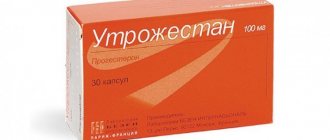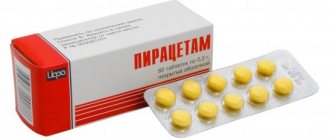Side effects
Possible side effects that occur during treatment with the drug:
- drowsiness, headache, attacks of fear, depression;
- stool disorders, gases (flatulence), vomiting and nausea;
- skin rashes;
- enlargement of the mammary glands in men;
- numbness of the limbs;
- hyperprolactinemia - increased prolactin hormone, galactorrhea (leakage of milk outside of lactation);
- impotence.
The following changes in laboratory parameters are possible:
- increased levels of liver enzymes of a transient nature;
- neutropenia, thrombocytopenia (decreased platelet concentration);
- hemolytic anemia - decreased hemoglobin concentration
During pregnancy
Cimetidine crosses the placental barrier and is found in breast milk and is therefore not prescribed or used with caution in pregnant and lactating women .
Cimetidine (Cimetidinum)
When used simultaneously with antacids containing magnesium hydroxide and aluminum hydroxide, the absorption of cimetidine may be reduced.
When used simultaneously with oral hypoglycemic agents, sulfonylurea derivatives, hypoglycemia was observed in rare cases.
When used simultaneously with tricyclic antidepressants, the concentration of tricyclic antidepressants in the blood plasma increases due to inhibition of their metabolism in the liver under the influence of cimetidine.
When used simultaneously with alprazolam, chlordiazepoxide, clobazam, clorazepate, diazepam, flurazepam, nitrazepam, triazolam, the concentration of benzodiazepines in the blood plasma increases due to inhibition of their metabolism in the liver under the influence of cimetidine. Possible increased sedative effect.
With simultaneous use, the concentration of alfentanil in the blood plasma increases.
With simultaneous use, the concentration of amiodarone in the blood plasma increases due to a slowdown in its metabolism under the influence of cimetidine.
When used simultaneously with atenolol, a case of the development of severe bradycardia has been described.
It is possible to increase the bioavailability of benzylpenicillin with simultaneous oral administration.
When used simultaneously with bopindolol, the concentration of bopindolol in the blood plasma increases; with bupivacaine - it is possible to increase the concentration of bupivacaine in the blood plasma; with valproic acid - the clearance of sodium valproate is slightly reduced, which may have clinical significance; with warfarin - the anticoagulant effect of warfarin may be enhanced and the risk of bleeding may increase.
When used simultaneously with vecuronium chloride, the effects of vecuronium chloride are enhanced; with verapamil - the effects of verapamil are enhanced; with gallopamil - the bioavailability of gallopamil increases by 40-50%; with dapsone - the concentration of dapsone in the blood plasma increases.
When used simultaneously with digoxin, both an increase and a decrease in the concentration of digoxin in the blood plasma is possible.
When used concomitantly with disopyramide, there is a report of a slight increase in the concentration of disopyramide in the blood plasma.
When used simultaneously with diltiazem and nifedipine, the concentration of diltiazem and nifedipine in the blood plasma increases due to inhibition of their metabolism in the liver under the influence of cimetidine. The effects of diltiazem and nifedipine may be enhanced.
When used simultaneously with zalcitabine, the concentration of zalcitabine in the blood plasma increases; with zidovudine - the renal secretion of zidovudine decreases, while its concentration in the blood plasma remains virtually unchanged.
When used simultaneously with indomethacin, a slight decrease in the concentration of indomethacin in the blood plasma is observed, with virtually no change in its anti-inflammatory effect.
In patients receiving carbamazepine, a transient increase in its plasma concentration is possible for several days after starting cimetidine, which may be accompanied by increased side effects.
When used simultaneously with carvedilol, the systemic exposure of carvedilol increases without changing its maximum concentration in blood plasma.
When used simultaneously with carmustine, myelodepression increases and there is a risk of developing severe neutropenia and thrombocytopenia.
With simultaneous use, the absorption of ketoconazole and itraconazole from the gastrointestinal tract decreases.
A case has been described of an increase in the concentration of clozapine in the blood plasma and the development of toxic effects with the simultaneous use of cimetidine with clozapine.
When used simultaneously with lacidipine, nimodipine, nisoldipine, nitrendipine, felodipine, the concentration of calcium channel blockers in the blood plasma increases.
With simultaneous use, there may be a slight decrease in the absorption of levothyroxine from the gastrointestinal tract.
With simultaneous use, the clearance of lidocaine moderately decreases and its concentration in the blood plasma increases, there is a risk of increased side effects of lidocaine.
When used simultaneously with loratadine, the concentration of loratadine in the blood plasma increases, no increased side effects were noted; with lornoxicam - the concentration of lornoxicam in the blood plasma increases; with mebendazole - the concentration of mebendazole in the blood plasma increases and its effectiveness increases.
When used concomitantly, cimetidine may reduce the gastrointestinal side effects of mexiletine.
When used simultaneously with melphalan, its bioavailability increases; with methadone - cases of apnea development in elderly patients have been described; with metformin - there may be a decrease in the clearance of metformin, the risk of developing lactic acidosis.
When used simultaneously with moclobemide, the concentration of moclobemide in the blood plasma increases and side effects increase; with moracizine - the concentration of moracizine in the blood plasma increases; with morphine - the inhibitory effect of morphine on breathing may be enhanced; with nebivolol - an increase in the concentration of nebivolol in the blood plasma is possible.
When used simultaneously with paroxetine, it is possible to increase the concentration of paroxetine in the blood plasma due to inhibition of its metabolism and reduced excretion, and there is a risk of increased side effects; with pindolol - it is possible to increase the concentration of pindolol in the blood plasma; with pirenzepine - there are reports of increased clinical effectiveness of cimetidine; with praziquantel - the concentration of praziquantel in the blood plasma increases significantly; with procainamide - the concentration of procainamide in the blood plasma increases and there is a risk of increased side effects, especially in elderly patients and with impaired renal function. This is due to a decrease in the excretion of procainamide by the kidneys under the influence of cimetidine by almost 1/3 or more.
When used simultaneously with propafenone, a slight increase in the concentration of propafenone in the blood plasma and an increase in the duration of the QRS are possible.
Cimetidine inhibits the activity of microsomal liver enzymes (including the CYP2D6 isoenzyme), this leads to inhibition of the metabolism of propranolol and metoprolol. Arterial hypotension may develop, as well as increased side effects of beta-blockers, especially in patients with impaired liver function.
When used simultaneously with riodipine, the concentration of riodipine in the blood plasma increases due to a slowdown in its metabolism in the liver under the influence of cimetidine.
When used simultaneously with rifampicin, the extrarenal clearance of cimetidine increases by 50%, which is apparently due to the induction of microsomal liver enzymes under the influence of rifampicin. Because total clearance is not affected, this interaction is believed to be of little clinical significance.
When used simultaneously with sertraline, the concentration of sertraline in the blood plasma moderately increases; with sucralfate - a slight decrease in the bioavailability of cimetidine cannot be ruled out; with theophylline - the concentration of theophylline in the blood plasma increases due to inhibition of its metabolism in the liver (mainly N-demethylation) under the influence of cimetidine, the toxic effect of theophylline develops.
With simultaneous use with terfenadine, a case of the development of ventricular arrhythmias has been described, apparently due to inhibition of the metabolism of terfenadine under the influence of cimetidine, which is a nonspecific inhibitor of microsomal liver enzymes.
When used simultaneously with phenindione, the anticoagulant effect of phenindione is enhanced due to a slowdown in its metabolism in the liver under the influence of cimetidine, which is an inhibitor of microsomal liver enzymes.
When used simultaneously with phenytoin, the concentration of phenytoin in the blood plasma increases and a toxic effect develops, very rarely - myelodepression.
When used simultaneously with fentanyl, the effects of fentanyl may be enhanced; with flecainide - the concentration of flecainide in the blood plasma increases due to a decrease in its renal clearance and metabolism in the liver under the influence of cimetidine; with fluvastatin - increased absorption of fluvastatin is possible; with fluorouracil - the concentration of fluorouracil in the blood plasma increases by 75%, the side effects of fluorouracil increase.
When used simultaneously with quinidine, the concentration of quinidine in the blood plasma increases, and there is a risk of increased side effects; with quinine - it is possible to reduce the excretion of quinine and increase its half-life, there is a risk of increased side effects; with chloramphenicol - cases of severe aplastic anemia have been described; with chlorpromazine - there are reports of both a decrease and an increase in the concentration of chlorpromazine in the blood plasma.
When used simultaneously with cyclosporine, a slight increase in the concentration of cyclosporine in the blood plasma cannot be excluded; with citalopram - it is possible to increase the concentration of citalopram in the blood plasma; with enalapril - an increase in the half-life of enalapril and an increase in its concentration in the blood plasma.
With simultaneous use, the plasma concentration of enoxacin (with intravenous administration), fleroxacin (with intravenous administration), and pefloxacin (with oral administration) increases; with epirubicin - the concentration of epirubicin in the blood plasma increases; with erythromycin - cimetidine inhibits the process of N-demethylation of erythromycin, so its metabolism and clearance from the body slows down, which leads to an increase in its concentration in the blood plasma and the possible development of side effects (nausea, vomiting, diarrhea, abdominal discomfort).
Alcohol - increases its concentration in the blood and activity/toxicity.
Nomides capsules 75 mg 10 pcs ➤ instructions for use
The drug oseltamivir is taken orally, regardless of meals or with meals. Treatment The drug should be started no later than 2 days after the development of symptoms of the disease. Adults and adolescents ≥ 12 years of age The recommended daily dose is 150 mg. The drug is prescribed in a dose of 75 mg (one capsule 75 mg or one capsule 30 mg + one capsule 45 mg) 2 times a day orally for 5 days. Children weighing more than 40 kg or aged ≥ 8 years Children who can swallow capsules can also be treated by taking 75 mg (one 75 mg capsule or one 30 mg capsule + one 45 mg capsule) twice daily within 5 days. Children aged ≥ 1 year The recommended dosage regimen for oseltamivir capsules is 30 and 45 mg. Body weight Recommended dose for 5 days ≤15 kg: 30 mg twice a day >15-23 kg: 45 mg twice a day >23-40 kg: 60 mg twice a day Prevention The drug should be started no later than 2 days after contact with patients. Adults and adolescents aged ≥ 12 years 75 mg (one 75 mg capsule or one 30 mg capsule + one 45 mg capsule) once daily orally for at least 10 days after contact with the patient. During a seasonal flu epidemic - 75 mg 1 time per day for 6 weeks. The preventive effect lasts as long as the drug is taken. Children weighing more than 40 kg or aged ≥ 8 years Children who can swallow capsules can also receive preventive therapy by taking 75 mg (one 75 mg capsule or one 30 mg capsule + one 45 mg capsule) once daily within 10 days. Children aged ≥ 1 year The recommended dosage regimen for oseltamivir capsules is 30 and 45 mg. The recommended dosage regimen for oseltamivir capsules is 30 and 45 mg. Body weight Recommended dose for 10 days ≤15 kg: 30 mg once daily >15-23 kg: 45 mg once daily >23-40 kg: 60 mg once daily Dosing in special cases Patients with impaired function kidneys: Treatment Patients with creatinine clearance more than 60 ml/min do not require dose adjustment. In patients with a creatinine clearance of 30 to 60 mL/min, the dose of oseltamivir should be reduced to 30 mg twice daily for 5 days. In patients with a creatinine clearance of 10 to 30 ml/min, the dose of oseltamivir should be reduced to 30 mg once daily for 5 days. For patients on chronic hemodialysis, oseltamivir at an initial dose of 30 mg can be taken before starting dialysis if flu-like symptoms appear within 48 hours between dialysis sessions. To maintain plasma concentrations at therapeutic levels, oseltamivir should be taken 30 mg after each dialysis session. For patients on peritoneal dialysis, oseltamivir should be taken at an initial dose of 30 mg before starting dialysis, then 30 mg every 5 days. The pharmacokinetics of oseltamivir in patients with end-stage chronic renal failure (with creatinine clearance ≤10 ml/min) not on dialysis have not been studied. In this regard, there are no dosage recommendations for this group of patients. Prevention Patients with creatinine clearance more than 60 ml/min do not require dose adjustment. In patients with a creatinine clearance of 30 to 60 ml/min, the dose of oseltamivir should be reduced to 30 mg once daily. In patients with creatinine clearance from 10 to 30 ml/min, it is recommended to reduce the dose of oseltamivir to 30 mg every other day. For patients on chronic hemodialysis, oseltamivir at an initial dose of 30 mg can be taken before starting dialysis. To maintain plasma concentrations at therapeutic levels, oseltamivir should be taken 30 mg after each subsequent odd-numbered dialysis session. For patients on peritoneal dialysis, oseltamivir should be taken at an initial dose of 30 mg before starting dialysis, then 30 mg every 7 days. The pharmacokinetics of oseltamivir in patients with end-stage chronic renal failure (with creatinine clearance less than 10 ml/min) not on dialysis have not been studied. In this regard, there are no dosage recommendations for this group of patients. Patients with impaired liver function No dose adjustment is required for the treatment and prevention of influenza in patients with mild to moderate hepatic impairment. The safety and pharmacokinetics of oseltamivir in patients with severe hepatic impairment have not been studied. Elderly and senile patients No dose adjustment is required for the prevention or treatment of influenza. Patients with weakened immune systems (after transplantation). For seasonal prophylaxis of influenza in immunocompromised patients aged ≥1 year - for 12 weeks, no dose adjustment is required.
Extemporaneous preparation of Nomides® suspension from capsules
In cases where adults, adolescents and children have difficulty swallowing capsules or there are signs of "aging" of the capsules, it is necessary to open the capsule and pour its contents into a small amount (maximum 1 teaspoon) of a suitable sweetened food product (normal chocolate syrup). sugar or unsweetened, honey, light brown sugar or table sugar dissolved in water, sweet dessert, sweetened condensed milk, applesauce or yogurt) to cover up the bitter taste. The mixture must be mixed thoroughly and given to the patient as a whole. The mixture should be swallowed immediately after preparation.
Capsules 75 mg
If patients require a dose of 75 mg , the following instructions should be followed:
1. Holding one Nomides® 75 mg capsule over a small container, carefully open the capsule and pour the powder into the container.
2. Add a small amount (no more than 1 teaspoon) of a suitable sweetened food (to cover the bitter taste) and mix well.
3. Mix the mixture thoroughly and drink it immediately after preparation. If there is a small amount of mixture left in the container, you should rinse the container with a small amount of water and drink the remaining mixture.
If patients require doses of 30-60 mg , the following instructions should be followed for proper dosing:
1. Holding one Nomides® 75 mg capsule over a small container, carefully open the capsule and pour the powder into the container.
2. Add 5 ml of water to the powder using a syringe with marks indicating the amount of liquid collected. Mix thoroughly for 2 minutes.
3. Draw the required amount of mixture into the syringe from the container according to the following table.
Body weight / Recommended dose / Amount of Nomides® mixture per 1 dose
≤15 kg / 30 mg / 2 ml
>15-23 kg / 45 mg / 3 ml
>23-40 kg / 60 mg / 4 ml
There is no need to collect undissolved white powder as it is an inactive filler. By pressing the plunger of the syringe, inject all its contents into the second container. Any remaining unused mixture should be discarded.
4. In a second container, add a small amount (no more than 1 teaspoon) of a suitable sweetened food to cover the bitter taste and mix well.
5. Mix the mixture thoroughly and drink it immediately after preparation. If there is a small amount of mixture left in the container, you should rinse the container with a small amount of water and drink the remaining mixture.
This procedure should be repeated before each dose of the drug.



